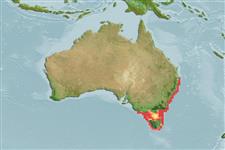Elasmobranchii (hajar och rockor) (sharks and rays) >
Myliobatiformes (Stingrays) >
Urolophidae (Round rays)
Etymology: Urolophus: Greek, oura = tail + Greek, lophos = crest (Ref. 45335).
Environment: milieu / climate zone / depth range / distribution range
Ekologi
marina bottenlevande; djupintervall 20 - 200 m (Ref. 9863), usually 80 - 180 m (Ref. 9863). Temperate; 27°S - 44°S, 141°E - 154°E
Indo-West Pacific: occurs in Australia, from southern tip of Queensland southward to Tasmania. A related or identical species is found off southern Western Australia in deep water.
Length at first maturity / Size / Vikt / Age
Maturity: Lm ?, range 26 - 31.8 cm
Max length : 44.0 cm TL hane/ej könsbestämd; (Ref. 9863)
Occurs on the outer continental shelf (Ref. 6871, 75154).
Last, P.R. and J.D. Stevens, 1994. Sharks and rays of Australia. CSIRO, Australia. 513 p. (Ref. 6871)
IUCN Red List Status (Ref. 130435)
Threat to humans
Harmless
Human uses
Ytterligare information
Age/SizeTillväxtLength-weightLength-lengthLength-frequenciesMorfometriMorfologiLarverLarvdynamikRekryteringAbundansBRUVS
referenserVattenbrukVattenbruksprofilAvelslinjerGenetikElectrophoresesÄrftlighetSjukdomarBehandlingNutrientsMass conversion
MedarbetareBilderStamps, Coins Misc.LjudCiguateraHastighetSimsättGälytaOtolithsHjärnstorlekSyn
Verktyg
Special reports
Download XML
Internet-källor
Estimates based on models
Preferred temperature (Ref.
123201): 13 - 20, mean 14.3 °C (based on 14 cells).
Phylogenetic diversity index (Ref.
82804): PD
50 = 0.5000 [Uniqueness, from 0.5 = low to 2.0 = high].
Bayesian length-weight: a=0.00813 (0.00366 - 0.01807), b=3.08 (2.88 - 3.28), in cm total length, based on LWR estimates for this (Sub)family-body shape (Ref.
93245).
Trofisk nivå (Ref.
69278): 3.5 ±0.4 se; based on size and trophs of closest relatives
Resiliens (Ref.
120179): Låg, lägsta populationsfördubblingstid 4,5-14 år (Assuming fecundity<100).
Fishing Vulnerability (Ref.
59153): Low to moderate vulnerability (34 of 100).
